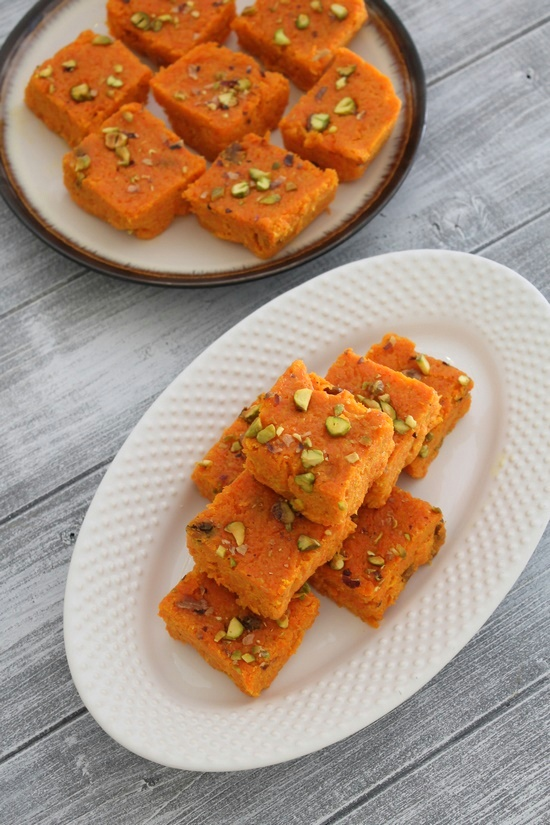Gajar Barfi, a decadent and rich Indian sweet treat, brings together the comforting flavors of carrots, condensed milk, cream, and khoya (mawa) to create a dessert that’s perfect for the festive season. “Gajar” translates to carrot in English, and this delightful mithai, also known as carrot burfi, is a firmer, sliceable twist on the much-loved gajar ka halwa.
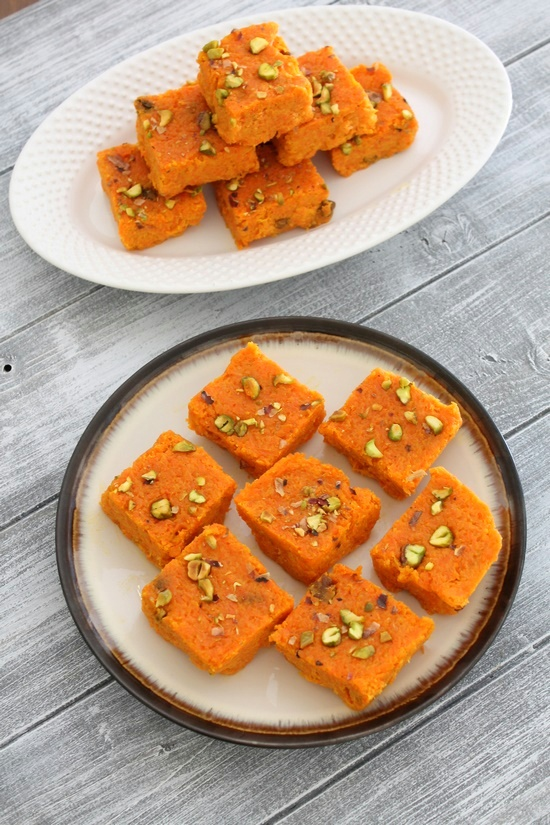
As the Diwali season approaches, sweet cravings begin to stir, and homemade treats fill our kitchens. Over the weekend, I prepared a generous batch of this Gajar Barfi along with a few other traditional Diwali goodies. The recipe yielded around 16 thick, rich squares—far more than what two people could finish. After we savored a couple of pieces, my husband carried the rest to his office, where they were devoured by his colleagues within minutes! Their enthusiastic response convinced me to share this easy and indulgent recipe here.
Gajar Barfi is a firmer, sliceable version of gajar halwa made with similar ingredients in different proportions. The key difference lies in reducing the moisture content and adding the right quantity of khoya to bind everything together.
Khoya, or mawa, is what gives this burfi its luxurious texture and richness. It contributes to the dense, fudgy consistency that is characteristic of a well-made barfi. As it cools, the khoya helps the mixture solidify, ensuring clean, sharp slices.
Another essential ingredient is sweetened condensed milk, which not only brings in sweetness but also lends creaminess and eliminates the need for prolonged cooking. Had we used plain milk and sugar instead, the mixture would need to simmer for much longer to reach the right consistency. So, the use of condensed milk here is a true time-saver—especially during the hustle and bustle of the festive season.
The end result is an indulgent dessert that strikes the perfect balance between taste, texture, and tradition. A single square is enough to satisfy sweet cravings, though no one will judge if you go back for seconds. With its melt-in-the-mouth texture and rich, nutty notes from khoya, this gajar barfi is a must-try for any celebration.
Whether you’re preparing sweets for family gatherings, sharing with friends, or gifting festive treats, this Gajar Barfi is a guaranteed crowd-pleaser that celebrates the spirit of Indian festivals in every bite.
Ingredients For Gajar Barfi:
- 10 large carrots (approximately 750 grams or 5½ cups, finely grated): Use fresh, tender carrots for the best flavor and vibrant color. Red or orange varieties both work well, but winter red carrots offer a naturally sweeter taste.
- ½ cup heavy whipping cream (or fresh homemade cream/malai): Adds richness and creaminess to the mixture, helping achieve that melt-in-the-mouth barfi texture.
- 200 grams sweetened condensed milk (equivalent to ½ cup + 2 tablespoons or ½ can or 7 oz): This provides both sweetness and a smooth, luxurious consistency, cutting down the need for extra sugar and cooking time.
- ¼ cup granulated sugar: Enhances sweetness, balancing the earthy flavor of carrots and the richness of khoya. Adjust slightly to taste, depending on the sweetness of your carrots and condensed milk.
- ½ cup khoya (mawa), grated or crumbled: Adds density and a traditional Indian sweet flavor. Khoya helps the barfi firm up as it cools, giving it a perfect fudge-like finish.
- ½ teaspoon green cardamom powder: Made from freshly ground seeds, this imparts a fragrant aroma and a warm, traditional flavor that complements the carrots beautifully.
- 2 tablespoons raisins: Optional but recommended for subtle bursts of sweetness and chewy texture in every bite.
- 2 tablespoons chopped pistachios, almonds, or cashews (for garnish): These not only enhance the visual appeal but also add a pleasant crunch and nutty richness. Toast lightly for added depth of flavor.
Step-by-Step Instructions:
1) Start by greasing an 8×8-inch square pan or any deep thali with high sides using a generous amount of ghee. This ensures the barfi doesn’t stick and can be removed cleanly later. Set it aside until you’re ready to pour in the mixture.
2) Rinse the carrots well under running water to eliminate any dirt or impurities. Peel or gently scrape the outer skin to achieve a cleaner, smoother texture. For a smaller batch, a box grater works perfectly to finely grate the carrots. This ensures even texture and helps the carrots cook uniformly while blending seamlessly into the barfi mixture. If you’re preparing a larger batch, opt for a food processor to speed up the process and ensure uniform shredding. Transfer the grated carrots to a heavy-bottomed pan and place it on medium heat.
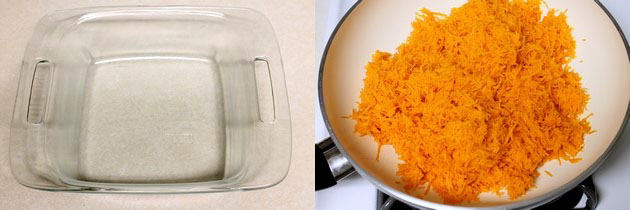
3) Pour in the heavy cream. It enhances the texture, giving the barfi a rich, soft, and melt-in-the-mouth consistency that’s characteristic of traditional Indian sweets.
4) Pour the sweetened condensed milk into the pan, followed by the sugar. Stir well to ensure the condensed milk and sugar coat the grated carrots evenly and begin to melt into the mixture. Their rich consistency not only sweetens the barfi but also accelerates the thickening process, helping the ingredients come together more quickly.
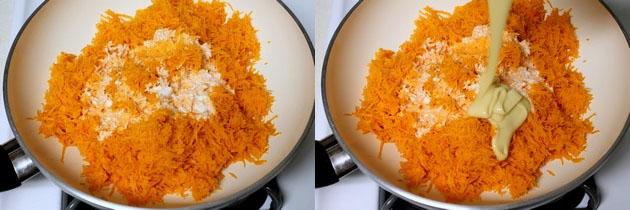
5) Stir everything well to combine, ensuring that the carrots are fully coated in the sweet creamy base.
6) Allow the mixture to come to a gentle simmer, letting the flavors begin to meld.
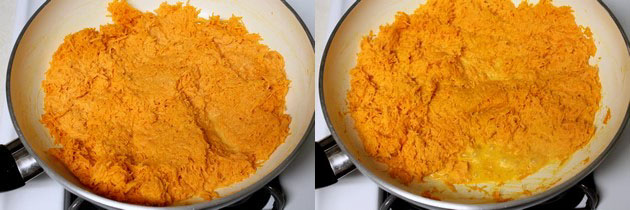
7) Keep cooking the mixture over medium heat, stirring frequently to prevent it from sticking or burning. As the mixture thickens and the carrots soften, make sure to continuously scrape the sides and bottom of the pan. This ensures even cooking and helps achieve a smooth, lump-free consistency essential for perfect barfi. Let the mixture cook until all the liquid is absorbed and evaporated.
8) By this time, the grated carrots will have softened and cooked down significantly. This process usually takes 20–25 minutes, depending on the moisture content of the carrots.
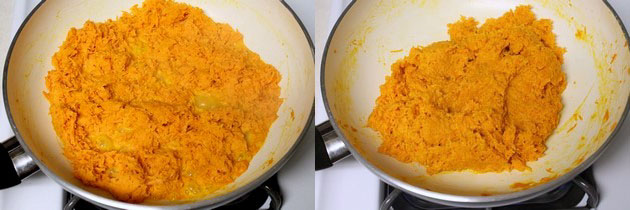
9) Now, grate or crumble the khoya (mawa) and add it to the pan. Stir it well into the carrot mixture. The khoya enriches the barfi, giving it a dense, fudge-like texture that’s typical of traditional Indian sweets.
10) Mix everything thoroughly so the khoya blends well with the carrot mixture. Continue to cook on medium heat for 7–8 minutes, stirring frequently. As the mixture cooks, it will gradually thicken and start to leave the sides of the pan, forming a cohesive mass—this is a clear sign that it’s ready to be set into barfi.
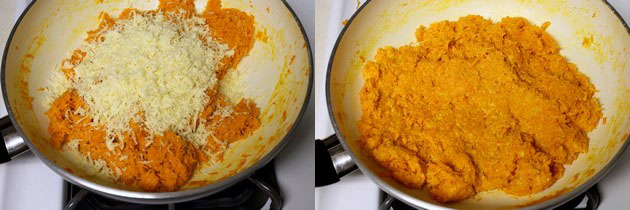
11) Add freshly ground cardamom powder and plump raisins for warm flavor and bursts of sweetness in every bite.
12) Give the mixture one final good stir to ensure everything is well combined. Once done, turn off the heat and let it rest for a couple of minutes before transferring it to the prepared pan.
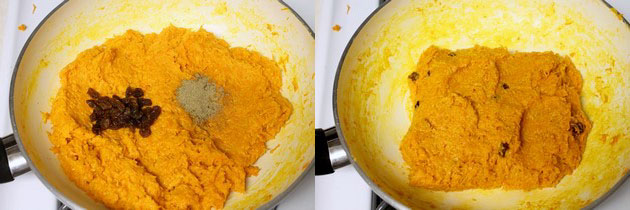
13) Quickly pour the hot carrot mixture into the greased pan, spreading it evenly with a spatula to create a smooth surface. Sprinkle chopped pistachios, almonds, or cashews over the top and gently press them down so they adhere well to the mixture.
14) Let the carrot barfi cool completely at room temperature without disturbing it. As it rests, the mixture gradually firms up and solidifies, allowing it to hold its shape. This setting process makes it much easier to slice the barfi into clean, well-defined squares or rectangles with a sharp knife. Patience here ensures perfect texture and presentation. Avoid refrigerating at this stage to ensure the texture sets naturally and remains soft yet fudgy. Once set, use a sharp knife to cut into 16 even squares or desired shapes.
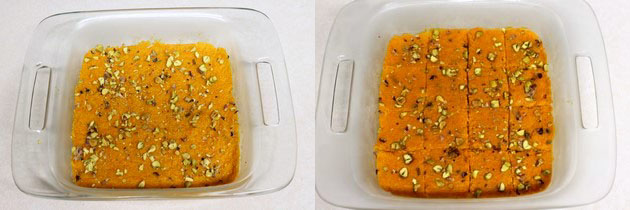
Carefully remove each piece and arrange them neatly on a serving plate. Store the remaining pieces in an airtight container. These delightful Gajar Barfis stay fresh for up to a week at room temperature or longer when refrigerated.
Expert Tips for Perfect Gajar Barfi
- Choose fresh, sweet carrots: Go for soft, succulent carrots that are naturally sweet in taste. The red Delhi carrots available during winter months are especially suited for barfi, as they add vibrant color and better taste. Avoid fibrous or dry carrots, as they affect texture and flavor.
- Grate finely for best results: Finely grating the carrots helps them cook evenly and merge smoothly into the barfi mixture for a consistent texture. For smaller portions, use a hand grater or box grater. When preparing in larger quantities, a food processor will save time and effort while maintaining a consistent texture.
- Cook with patience: One of the keys to a great barfi is slow cooking. Simmer the mixture over medium heat, giving the carrots time to soften slowly and release their natural moisture, which deepens the flavor. Keep stirring at regular intervals and scrape the bottom and sides to prevent sticking or burning as it thickens.
- Use good-quality khoya (mawa): Khoya adds richness and a traditional mithai-like texture. For the best results, use fresh, unsweetened khoya. Homemade khoya is ideal, but you can also buy it from a reliable sweet shop. Avoid frozen or processed khoya as it may compromise flavor and texture.
- Don’t skip greasing the tray: Before pouring the hot mixture into a tray or plate, make sure it’s well-greased with ghee. This prevents sticking and allows the barfi to set cleanly, making demolding and cutting much easier.
- Set while the mixture is still hot: Immediately transfer the hot carrot mixture to the prepared tray. Use a spatula to spread and flatten the surface evenly. Add your favorite chopped nuts and gently press them into the top so they adhere while the mixture is warm.
